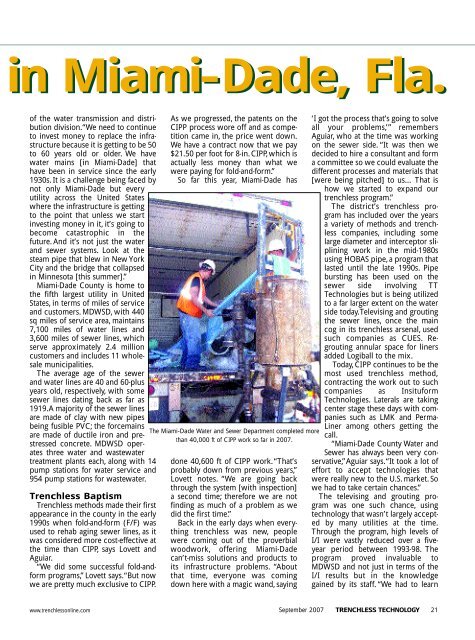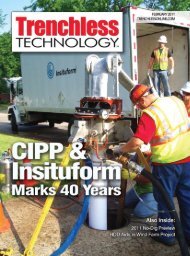Author: Professor, Dr. Dietrich Stein - TrenchlessOnline
Author: Professor, Dr. Dietrich Stein - TrenchlessOnline
Author: Professor, Dr. Dietrich Stein - TrenchlessOnline
You also want an ePaper? Increase the reach of your titles
YUMPU automatically turns print PDFs into web optimized ePapers that Google loves.
in Miami-Dade, Fla.<br />
of the water transmission and distribution<br />
division.“We need to continue<br />
to invest money to replace the infrastructure<br />
because it is getting to be 50<br />
to 60 years old or older. We have<br />
water mains [in Miami-Dade] that<br />
have been in service since the early<br />
1930s. It is a challenge being faced by<br />
not only Miami-Dade but every<br />
utility across the United States<br />
where the infrastructure is getting<br />
to the point that unless we start<br />
investing money in it, it’s going to<br />
become catastrophic in the<br />
future. And it’s not just the water<br />
and sewer systems. Look at the<br />
steam pipe that blew in New York<br />
City and the bridge that collapsed<br />
in Minnesota [this summer].”<br />
Miami-Dade County is home to<br />
the fifth largest utility in United<br />
States, in terms of miles of service<br />
and customers. MDWSD, with 440<br />
sq miles of service area, maintains<br />
7,100 miles of water lines and<br />
3,600 miles of sewer lines, which<br />
serve approximately 2.4 million<br />
customers and includes 11 wholesale<br />
municipalities.<br />
The average age of the sewer<br />
and water lines are 40 and 60-plus<br />
years old, respectively, with some<br />
sewer lines dating back as far as<br />
1919.A majority of the sewer lines<br />
are made of clay with new pipes<br />
being fusible PVC; the forcemains<br />
are made of ductile iron and prestressed<br />
concrete. MDWSD operates<br />
three water and wastewater<br />
treatment plants each, along with 14<br />
pump stations for water service and<br />
954 pump stations for wastewater.<br />
Trenchless Baptism<br />
Trenchless methods made their first<br />
appearance in the county in the early<br />
1990s when fold-and-form (F/F) was<br />
used to rehab aging sewer lines, as it<br />
was considered more cost-effective at<br />
the time than CIPP, says Lovett and<br />
Aguiar.<br />
“We did some successful fold-andform<br />
programs,” Lovett says.“But now<br />
we are pretty much exclusive to CIPP.<br />
www.trenchlessonline.com<br />
As we progressed, the patents on the<br />
CIPP process wore off and as competition<br />
came in, the price went down.<br />
We have a contract now that we pay<br />
$21.50 per foot for 8-in.CIPP,which is<br />
actually less money than what we<br />
were paying for fold-and-form.”<br />
So far this year, Miami-Dade has<br />
The Miami-Dade Water and Sewer Department completed more<br />
than 40,000 ft of CIPP work so far in 2007.<br />
done 40,600 ft of CIPP work.“That’s<br />
probably down from previous years,”<br />
Lovett notes. “We are going back<br />
through the system [with inspection]<br />
a second time; therefore we are not<br />
finding as much of a problem as we<br />
did the first time.”<br />
Back in the early days when everything<br />
trenchless was new, people<br />
were coming out of the proverbial<br />
woodwork, offering Miami-Dade<br />
can’t-miss solutions and products to<br />
its infrastructure problems. “About<br />
that time, everyone was coming<br />
down here with a magic wand, saying<br />
‘I got the process that’s going to solve<br />
all your problems,’” remembers<br />
Aguiar, who at the time was working<br />
on the sewer side. “It was then we<br />
decided to hire a consultant and form<br />
a committee so we could evaluate the<br />
different processes and materials that<br />
[were being pitched] to us… That is<br />
how we started to expand our<br />
trenchless program.”<br />
The district’s trenchless program<br />
has included over the years<br />
a variety of methods and trenchless<br />
companies, including some<br />
large diameter and interceptor sliplining<br />
work in the mid-1980s<br />
using HOBAS pipe, a program that<br />
lasted until the late 1990s. Pipe<br />
bursting has been used on the<br />
sewer side involving TT<br />
Technologies but is being utilized<br />
to a far larger extent on the water<br />
side today.Televising and grouting<br />
the sewer lines, once the main<br />
cog in its trenchless arsenal, used<br />
such companies as CUES. Regrouting<br />
annular space for liners<br />
added Logiball to the mix.<br />
Today, CIPP continues to be the<br />
most used trenchless method,<br />
contracting the work out to such<br />
companies as Insituform<br />
Technologies. Laterals are taking<br />
center stage these days with companies<br />
such as LMK and Perma-<br />
Liner among others getting the<br />
call.<br />
“Miami-Dade County Water and<br />
Sewer has always been very conservative,”Aguiar<br />
says.“It took a lot of<br />
effort to accept technologies that<br />
were really new to the U.S. market. So<br />
we had to take certain chances.”<br />
The televising and grouting program<br />
was one such chance, using<br />
technology that wasn’t largely accepted<br />
by many utilities at the time.<br />
Through the program, high levels of<br />
I/I were vastly reduced over a fiveyear<br />
period between 1993-98. The<br />
program proved invaluable to<br />
MDWSD and not just in terms of the<br />
I/I results but in the knowledge<br />
gained by its staff. “We had to learn<br />
September 2007 TRENCHLESS TECHNOLOGY 21








